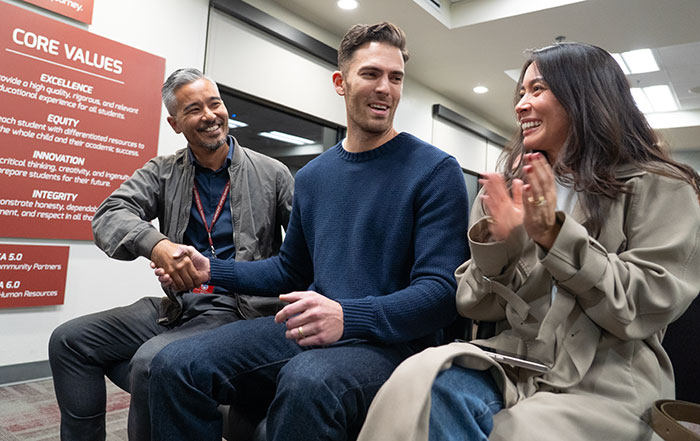CUSD’s super finds Claremont to be a good fit
In June, a fresh face joined Claremont Unified School District, that of new Superintendent of Schools Jim Elsasser.
Though only 6 months into his post helming Claremont schools, Mr. Elsasser (who most recently served as assistant superintendent of human resources for the Anaheim City School District) has made a good impression with school board members and district faculty and staff.
Oakmont Elementary School Principal Stacey Stewart notes that Mr. Elsasser has been very accessible and supportive of school activities.
“There seems to be, so far, a very good working relationship with the new superintendent,” CHS teacher Dave Chamberlain, president of the faculty union, noted in an interview held at the beginning of the school year.
His performance so far is reassuring for a district that went through 3 district heads and an interim superintendent of schools between 2006 and Mr. Elsasser’s hire
The COURIER recently caught up with Mr. Elsasser to learn more about his thoughts and impressions on his job and on the school district as he moves forward in his first year of service.
What have you learned about Claremont and CUSD in your time as superintendent?
Mr. Elsasser: The partnership that exists between the city and the school district lends itself to student focus and success. Students count! Many activities are designed to engage our youth, be it recreational time through TRACKS and/or the YAC, academic support through CLASP and the colleges, or participating in fine arts, students are at the core of what we do.
Proposition 30 passed in the last election. Have there been any effects of this passage so far? And what will be the effects in the coming months?
Mr. Elsasser: We are all very grateful to the voters for supporting Proposition 30. While Proposition 30 does not bring us any additional funding, we have avoided an additional reduction to our revenue that [would have] totaled approximately $3.3 million per year on an ongoing basis.
What is the financial status of CUSD as well as its financial prospects for the coming year(s)?
Mr. Elsasser: The Board of Education will be presented with the first interim financial report on Thursday, December 20. It indicates that the district will be able to meet its financial obligations for the current year (2012-2013), as well as the 2 subsequent fiscal years (2013-2014 and 2014-2015). This assumes no significant changes in the budget other than routine cost escalations related to the price of goods and services, and the movement of staff along established salary schedules.
CUSD is doing relatively well financially in comparison to many other districts that are having to implement additional cost-saving measures in spite of the passage of Proposition 30. The longer-term future will depend greatly on whether or not the state begins to fund its financial obligations to schools, as well as to repay the funding reductions it has implemented over the last several years.
What do you see as some of the greatest accomplishments of the Claremont Unified School District and the CUSD community in the months that you have been in office as superintendent?
Mr. Elsasser: I am not sure 6 months as superintendent can be used as a measure for greatest accomplishments. However, some early accomplishments that come to mind include working closely with the board of education to analyze baseline data related to the 6 strategic goals that were adopted in November 2011, to determine areas of strength and areas for growth, and to create action steps to continually address the challenges in each of the 6 priority goals.
Other accomplishments include taking the time to meet with and listen to the community—not jumping into change for the sake of change; forming ties with key community members and district stakeholder groups that permit collaboration; working with cabinet to be fiscally prudent in our spending decisions; building on a solid instructional foundation, i.e. expanding Professional Learning Communities, data chats and professional development opportunities; being able to offer programs that invite students to participate and thrive physically, emotionally and mentally; and finally, working with an outstanding and dedicated staff throughout this district that works tirelessly each and every day to ensure our students are receiving a top-quality education.
What does CUSD do well, and what can it do better?
Mr. Elsasser: I believe CUSD does an excellent job of offering a well-rounded education for all students. Each of our elementary schools has its own unique personality and characteristics, and our families are able to choose which school they feel will best meet their child’s needs and strengths.
We are also very fortunate that, through the assistance of the Claremont Educational Foundation and the generous donations of our parents and community, we are able to continue to offer arts and music as part of our elementary students’ education. Our intermediate school and high schools also offer many extracurricular and co-curricular activities and classes in addition to the rigorous academic courses that encourage students to explore their own interests and passion(s).
Has the recent shooting in Newton, Connecticut made you think more about access to and education about mental health issues in Claremont schools? If so, what are your thoughts on the matter?
Mr. Elsasser: Mental health issues have been in the forefront of educational institutions with the signing of the 2011-2012 California State budget, which repealed the mandate upon county mental health departments to provide services for eligible special education students in accordance with their Individualized Education Programs (IEPs).
Now, it is incumbent upon each school district to decide how to provide the Educationally Related Mental Health Services that have been under the purview of the Department of Mental Health since1984. Educationally Related Mental Health Services are defined as services provided to a student whose behavioral and emotional needs are documented to be [higher] in frequency, duration or intensity, affect their ability to benefit from their special education program, and are manifested at school, at home and in the community.
Claremont Unified has been adjusting to this new responsibility since last June. Our staff has been actively exploring avenues to expand support to students and families faced with mental health issues. We are in the process of reviewing current job assignments and have determined there is need to expand our counseling services to include an Educationally Related Mental Health Services (ERMHS) Counselor to our certificated staff. A new job description is being written and will be presented in an upcoming board of education meeting for approval.
What do you view as some of the challenges that CUSD schools, and California schools as a whole, face?
Mr. Elsasser: Recent years have seen the pace of change in education accelerate at all levels as educators and policy makers instigate reforms aimed at raising academic achievement in the United States to a world-class level. Perhaps nowhere has the pace and scale of change been more dramatic than in the realm of K–12 academic standards. In 2009, 48 states, including California, signed a memorandum of agreement to a state-led process—the Common Core State Standards Initiative—to produce a set of K–12 standards in the foundational subjects of English language arts and mathematics.
Claremont Unified is vigorously preparing for this transition by supporting teachers with a variety of professional development activities, conducting materials alignment studies and assessing technological needs. In addition, several committees have been formed that are analyzing and planning for needs related to communication, curriculum, assessments and technology. Each of these committees is developing plans of action to support teachers, students and parents for the transition to the Common Core State Standards.
What are your top priorities with regards to CUSD for 2013?
Mr. Elsasser: In November 2011, the Board of Education adopted 6 strategic goals for CUSD which include: a focus on increasing student achievement; educating the whole child; hiring, retaining and supporting highly qualified staff; maintaining a balanced budget; providing safe, clean and appropriate facilities; and engaging our families and the community to increase student success. My priority during 2013 will be to ensure we are all working together to meet those strategic goals.
When the COURIER first interviewed you, you said you plan to stay in the district for a while. Has this aim changed or are you still committed to staying a significant period?
Mr. Elsasser: Over the past 6 months, I have really enjoyed working in this district and with the entire community of Claremont. I believe CUSD is a match for me and I look forward to working here for many years to come.
—Sarah Torribio
storribio@claremont-courier.com










0 Comments